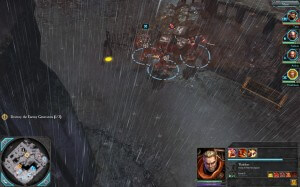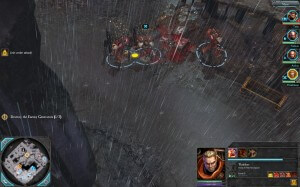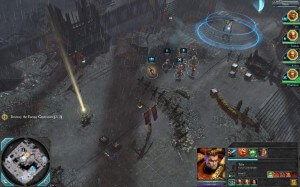This is going to be a short review, since Dawn of War II and it’s accompanying add-on Chaos Rising have been available since 2009. I have only recently gotten around to playing it, and I wanted to give it a fair shake. The game received fairly mixed reviews from people I knew, but a solid 75-85 from gaming sites and magazines. Let’s get down to the nitty-gritty. In no particular order:
Plot
The introduction video to the game is mildly deceptive and completely vague – I have linked it here. Upon watching it, you get the distinct impression that the Eldar may be the primary ‘villain’ of the game. The very first mission however, deals with Orks – who don’t even feature at all in the cinematic. The game does hint at something even more sinister though. This becomes apparent shortly thereafter.
The game begins with you, the Force Commander, and Sergeant Tarkus, leading a group of Tactical (Standard) Marines, landing on a war-torn planet of Calderis. You and Tarkus are members of the Blood Ravens chapter of the Imperium of Man. Calderis is one of the core recruiting worlds for the Blood Ravens. An assault by not 1, not 2, but 3 different alien races was thought to be unheard of. Yet, here you are. Stuck in battle against some of nastiest nasties that the universe has seen.
As you continue through the campaign you will pick up a few other squad members: Cyrus, the Scoutmaster; Avitus, the Heavy Weapons Specialists; and Thaddeus, the Assault Marines. Each will provide different abilities to help you succeed in your missions. Without revealing too much of the individual missions, the plot essentially revolves around you and your Chapter attempting to retake Calderis from the Orks, who are being riled up by the Eldar, who hope to cause a massive Ork invasion in order to stop or slow down the attacking Tyranids.
Gameplay & Style
Those of you who remember the original Dawn Of War may have come here expecting a fully-fleshed out Real-Time strategy game. You will, sadly, be disappointed. Dawn Of War II and Chaos Rising are Real-Time Strategy games, for sure, but in Single Player they do not feature some cornerstones such as resource management and base building. Instead, you are thrown into direct control of squads of Space Marines. There are no reinforcements (unless you get people to specifically placed beacons throughout the maps) and if a squad loses all it’s health it becomes incapacitated until another squad can revive them. In Multiplayer you control a small base that is primarily used to build units. Your units then go forth and capture resource nodes (Power & Requisition, as in the original Dawn of War) to help you build your new units. This was all a major departure from Dawn of War and initially had me a little annoyed.
However, as the game progresses, you notice that your squads are changing. They are increasing in power, you can modify their armaments, and customize them. They are still Blood Ravens, but the gear they carry can be matched to fit your play style. Don’t like guns? Take your Assault Marines and your Force Commander, equip them with a simple bolt pistol and an upgrade Chainsword or Power Fist. Let them charge headlong into battle (this is what I do). Love guns? Take your Tactical Marines and your Devastators, equip them with Heavy Bolters, Missile Launchers, or Plasma Rifles. Watch them roast the xenos from safety. Cyrus can even receive a Shotgun or a Sniper Rifle, based on your preference. They clearly wanted a new direction for Dawn of War II and I think that they found a good compromise here.
The gameplay is pretty fast-paced in Single Player. The way your map score is resolved is based on 3 factors: Fury (% of enemies killed), Speed (how long did it take your to complete the objectives), and Resilience (how many of your squads ever got incapacitated). I very rarely received more than 1 star for Speed. I like to take my time and clean the map off, and explore every nook and crannie. To be punished for that was kind of saddening and I don’t really understand it. The Blitz mentality is very frustrating.
Graphics
This game, in 2009, was stunningly gorgeous. The graphics have held up pretty well into 2013. The Warhammer 40k universe is dark, bloody, and visceral. This carries over pretty well into the game. In melee combat chainsaws literally sever limbs and cut things in half. The environment is occasionally destructible (the Force Commander can charge in and break down trees and barriers, Assault Marines send trees and troops flying when they swoop in from the skies) and alive. When the Tyranids show up, everything begins to look very alien, but in a subtle fashion. It’s a nice visual touch that I appreciated. Just enough to let you know that Calderis is under siege.
Overall
I haven’t finished beating the game yet. I have invested about 2 weeks into playing it. I am thoroughly enjoying it though, and it was certainly worth the Steam Sale price that I bought it at. If you like a good, graphically impressive game, with a solid plot (even though there isn’t too much in the way of character development) I highly recommend it. Look me up on Steam and we’ll play some multiplayer even.
Screenshots



“Strike from the skies, brothers!”
Mike, out.
Like this:
Like Loading...


